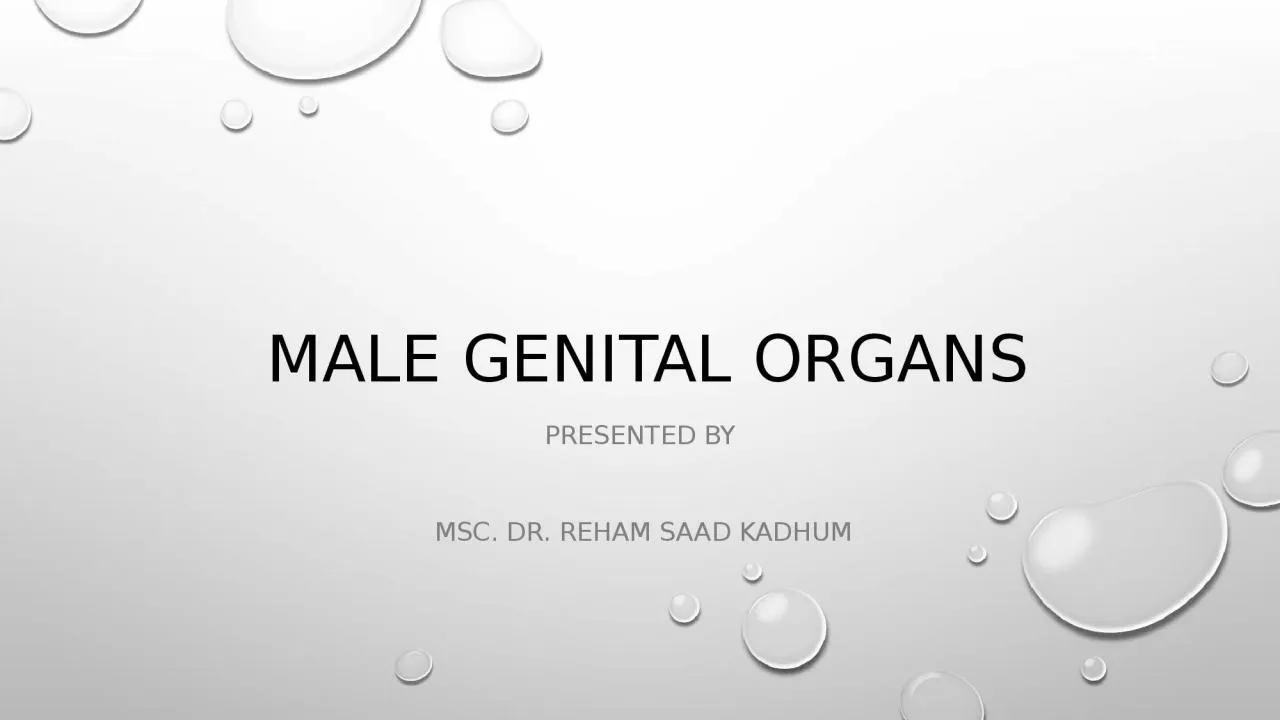PPT-Male Genital organs Presented by
Author : udeline | Published Date : 2024-02-09
Msc Dr Reham Saad Kadhum Vas Deferens The vas deferens is a thickwalled tube about 18 in 45 cm long that conveys mature sperm from the epididymis to the
Presentation Embed Code
Download Presentation
Download Presentation The PPT/PDF document "Male Genital organs Presented by" is the property of its rightful owner. Permission is granted to download and print the materials on this website for personal, non-commercial use only, and to display it on your personal computer provided you do not modify the materials and that you retain all copyright notices contained in the materials. By downloading content from our website, you accept the terms of this agreement.
Male Genital organs Presented by: Transcript
Msc Dr Reham Saad Kadhum Vas Deferens The vas deferens is a thickwalled tube about 18 in 45 cm long that conveys mature sperm from the epididymis to the ejaculatory duct and the urethra . your sexual health Genital warts 2 Genital warts Genital warts are the most common viral sexually transmitted infection (STI). They are caused by the human papilloma virus (HPV) which can be passe Alison Byrne. 14. th. June 2014. African Women’s Service. Heart of England NHS Trust. What is FGM?. The term “Female Genital Mutilation” [also called “female genital cutting” comprises all procedures that involve partial or total removal of the external female genitalia, or other injury to the female genital organs for non medical reasons.. Giulia De . Vettori. SLCC Bio 1010. Period 6. Human papilloma. virus. HPV is a DNA virus that affects the anus, genital track, or throat, and is the most common STD. . . It. is spread through any type of sexual intercourse such as oral, vaginal, or anal sex. . . 2. Learning Objectives. Upon completion of this content, the learner will be able to. Describe the epidemiology of genital HPV infection in the U.S.;. Describe the pathogenesis of genital HPV;. Discuss the clinical manifestations of genital HPV infection;. Simplex Virus Infection. Herpes Simplex Virus (. HSV) Type 2. 2. Learning Objectives. Describe the epidemiology of genital HSV in the U.S.. Describe the pathogenesis of genital HSV.. Discuss the clinical manifestations of genital HSV.. Simplex Virus Infection. Herpes Simplex Virus (. HSV) Type 2. 2. Learning Objectives. Describe the epidemiology of genital HSV in the U.S.. Describe the pathogenesis of genital HSV.. Discuss the clinical manifestations of genital HSV.. 1Eliminating female genital mutilation the imperativeThe term 145female genital mutilation146 also called 145female genital cutting146 and 145female genital mutilation/cutting146 refers to all procedu Done by:. Tasneem. . abue. . tailakh. . . Safaa. . alijla. . . Infection of the genital tract. - Bacterial. - Viruses . - Fungi . Female Genital Mutilation/Cutting. Overview. An estimated 100 million to 140 million girls and women worldwide have undergone female genital mutilation/cutting (FGM/C) and more than 3 million girls are at risk for cutting each year on the African continent alone.. procedures. Paolo . Mezzana. . MD,PhD. . Delle. Medical Center . Rome,Italy. Why?. Genital diversity . Exactly what constitutes ‘normal’ female genitalia is an area of medicine in which very few studies have been published. The handful of articles that do outline the measurements of female genitalia vary in their definition of hypertrophy and . What is Genital Herpes?. Sexually transmitted infection caused by a virus. Common signs and symptoms of initial infection. Small blisters and/or ulcers in the genital area, buttocks, or anus, or the lip and mouth area.. Adrian Mindel Genital herpes is the most common cause of genital ulceration in the developed world. More than 20000 cases of genital herpes are reported annually from sexually transmitted disease (STD Genital herpes is caused by two viruses called Herpes simplex, types and . The viruses are very similar and both can cause blisters or ulcers. When these occur on the face they are know Associate Professor, Pathology. Sri Venkateswara Institute of Medical Sciences. Tirupathi. MALE GENITAL TRACT- PENIS. Congenital anomalies . Hypospadias. Epispadias. Phimosis. Inflammation. Tumors .
Download Rules Of Document
"Male Genital organs Presented by"The content belongs to its owner. You may download and print it for personal use, without modification, and keep all copyright notices. By downloading, you agree to these terms.
Related Documents














